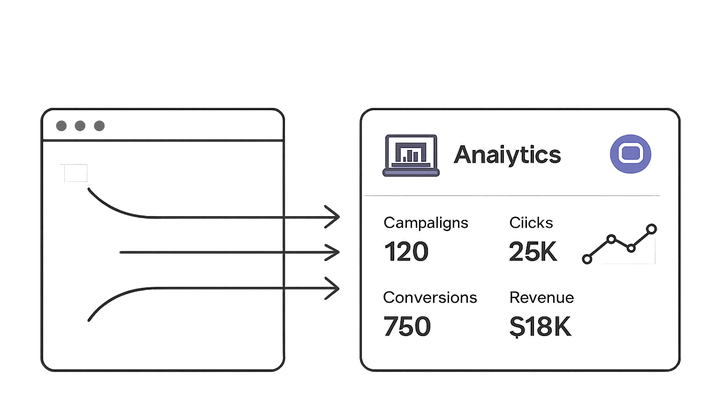Published on 2025-06-29T19:08:09Z
Tracking Pixel: What Is It and How Is It Used in Campaign Tracking & Analytics?
A tracking pixel, also known as a web beacon or pixel tag, is a 1×1 transparent graphic embedded in a webpage, email, or ad that triggers an HTTP request when loaded. Campaign tracking & analytics tools use these requests to collect data about user interactions—such as page views, email opens, and ad impressions—without requiring visible elements or relying on third-party cookies. Pixels capture information like IP address, user agent, referrer URL, and custom parameters (e.g., UTM tags), enabling marketers to attribute traffic sources, measure campaign performance, and analyze user behavior. Unlike cookies, tracking pixels operate at the server level, providing data even when cookies are blocked or deleted. By integrating with platforms like Plainsignal for cookie-free analytics or using UTM parameters generated by UTMGuru, pixels become a powerful yet lightweight method for precise attribution and real-time reporting. However, privacy regulations and ad blockers can limit their effectiveness, so understanding best practices is essential for reliable data.
Tracking pixel
A 1×1 transparent pixel that fires an HTTP request to track user interactions for campaign attribution and analytics across web, email, and ads.
Definition and Purpose
This section defines what a tracking pixel is and explains its purpose in campaign tracking & analytics.
-
What is a tracking pixel?
A tracking pixel is a 1×1 transparent image embedded on web pages or in emails that triggers an HTTP request when loaded, capturing data about user interactions without visible interface elements.
- Common names:
Also known as web beacons, pixel tags, or clear GIFs.
- Primary purpose:
Collects data like page views, email opens, and ad impressions invisibly.
- Common names:
-
Why use tracking pixels?
They provide granular insight into user behavior and campaign performance, working across channels and bypassing cookie limitations.
- Cross-channel visibility:
Tracks interactions on web, email, and ad platforms for unified reporting.
- Server-level tracking:
Captures events even when cookies are blocked or deleted.
- Cross-channel visibility:
How Tracking Pixels Work
This section describes the mechanism by which tracking pixels capture and transmit user interaction data.
-
Requesting the pixel
When content loads, the browser sends an HTTP GET request for the 1×1 pixel image, including headers and URL parameters.
- Http headers:
Includes referrer, user-agent, and any first-party cookies.
- Url parameters:
Custom parameters (e.g., UTM tags) appended to the pixel URL enable campaign attribution.
- Http headers:
-
Data processing
The server logs the request, extracts relevant parameters, and stores the event data for analytics processing.
- Real-time logging:
Events are processed in near real time for up-to-date dashboards.
- Data storage:
Captured data is indexed for segmentation, reporting, and historical analysis.
- Real-time logging:
Integration with SaaS Tools
Examples of implementing tracking pixels using popular SaaS platforms in the campaign tracking & analytics industry.
-
Plainsignal (cookie-free analytics)
PlainSignal provides a lightweight, cookie-free tracking pixel through a JavaScript snippet.
- Setup:
Place the snippet in your site’s <head> or before the closing </body> tag to enable pixel tracking.
- Code example:
<link rel=\"preconnect\" href=\"//eu.plainsignal.com/\" crossorigin /> <script defer data-do=\"yourwebsitedomain.com\" data-id=\"0GQV1xmtzQQ\" data-api=\"//eu.plainsignal.com\" src=\"//cdn.plainsignal.com/plainsignal-min.js\"></script>
- Setup:
-
Utmguru (utm parameter builder)
UTMGuru simplifies the creation and management of UTM-tagged URLs for precise campaign attribution.
- Generating utms:
Use the UTM builder or Chrome extension to define source, medium, campaign, term, and content parameters.
- Link management:
Save and list generated UTM URLs for consistent reuse across campaigns and reports.
- Generating utms:
Use Cases and Benefits
Key scenarios where tracking pixels enhance marketing analytics and performance measurement.
-
Campaign attribution
Tracks traffic sources and campaign effectiveness by capturing UTM and referral data.
-
Email and ad monitoring
Measures email opens and ad impressions even when cookies are blocked.
-
Behavioral insights
Collects data on page views, scroll depth, and engagement to analyze user journeys.
Limitations and Best Practices
Challenges in using tracking pixels and recommended best practices to ensure accurate and compliant data collection.
-
Privacy and compliance
Ensure GDPR, CCPA, and other regulations compliance by obtaining user consent when necessary.
-
Ad blockers and blocking
Consider server-side or first-party implementations as fallbacks to mitigate ad-block interference.
-
Performance considerations
Load asynchronously and optimize asset delivery to minimize impact on page speed and user experience.
